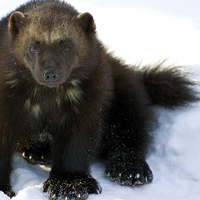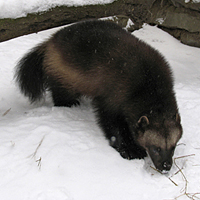Wolverine
Scientific name: Gulo gulo



Cover photos credit: istockPhoto.com (left and middle) and Dave Watts (right)
Status
Threatened
“Threatened ” means the species lives in the wild in Ontario, is not endangered, but is likely to become endangered if steps are not taken to address factors threatening it.
Date added to the Species at Risk in Ontario List
The wolverine was already assessed as threatened when the Endangered Species Act took effect in 2008. It was reassessed as threatened in 2014.
What it looks like
The Wolverine is a powerful animal and is the largest member of the weasel family (Mustelidae). It resembles a small bear with a bushy tail, short legs, and large paws with semi-retractable claws. Wolverines are about the same size as a medium-sized dog when fully grown, ranging from 65 to 87 centimetres in length. It has dark brown fur with pale golden-brown stripes running along the sides of the body. The Wolverine has a large head with a dark brown face, sometimes with a light silvery facial mask, and has ears that are short and rounded. Wolverines also have unique markings on their chest which have been used to identify individuals.
Wolverines mainly scavenge on moose and caribou, which is a favourite winter food. They also eat beavers, snowshoe hares, squirrels, voles, and sometimes berries. The Wolverine has very strong jaws that it uses to crush bones and frozen carcasses.
Where it lives
Wolverines usually live alone and roam across large territories that vary from 500 to 1500 square kilometres or more. Females build dens under snow-covered boulders, fallen logs, and occasionally in snow drifts. Researchers are still learning about the ecology and habitat needs of the Wolverine in Ontario.
Where it’s been found in Ontario
Historically, Wolverines were found throughout most of Ontario. Today, they are primarily found in the northwest boreal forest and coastal tundra; however, recent studies show some re-colonization of their historical northeastern range.
View a Larger version of this map (PDF)
What threatens it
The exact number of Wolverines living in Ontario is unknown; however, best estimates suggest there may be several hundred wolverines in Ontario. The main threat to the Wolverine is habitat loss due to forest clearing, and habitat fragmentation often associated with mineral extraction, forestry, and road creation.
Wolverines have low birth rates compared to other large carnivores and occur in low numbers across the landscape, which makes them less able to recover from mortality due to incidental trapping or road kills.
Action we are taking
Threatened species and their general habitat are automatically protected.
Recovery strategy
A recovery strategy advises the ministry on ways to ensure healthy numbers of the species return to Ontario.
Read the executive summary and full document (November 22, 2013).
Government response statement
A government response statement outlines the actions the government intends to take or support to help recover the species.
Read the government response statement (December 16, 2016)
Review of progress
A review of progress made toward protecting and recovering a species is required no later than the time specified in the species’ government response statement, or not later than five years after the government response statement is published if no time is specified.
Read the report on progress towards the protection and recovery of 18 species at risk, including Wolverine (2021).
Habitat protection
General habitat protection - June 30, 2013
What you can do
Report a sighting
- The Ministry of Natural Resources and Forestry tracks species at risk such as the wolverine. Report a sighting of an endangered animal or plant to the Natural Heritage Information Centre. Photographs with specific locations or mapping coordinates are always helpful.
- Appreciate Wolverines and don’t harm them. Wolverines are shy and normally avoid humans. As with all wildlife, be respectful and keep a safe distance.
Volunteer
- Volunteer with your local nature club or provincial park to participate in surveys or stewardship work focused on species at risk.
- The Wolverine Foundation Inc. and Wildlife Conservation Society Canada have both worked in partnership with the Ministry of Natural Resources in Ontario to undertake cooperative research on the Wolverine, including the Ontario Wolverine Project (2003-2005). For more information, visit: www.wolverinefoundation.org.
Be a good steward
- Private land owners have a very important role to play in species recovery. You may be eligible for stewardship programs that support the protection and recovery of species at risk and their habitats.
Report illegal activity
- Report any illegal activity related to plants and wildlife to
1-877-TIP-SMNR (847-7667) .
Quick facts
- Wolverines mark their territory with urine and a musty-smelling scent from glands at the base of the tail, which led to its nickname “skunk-bear”. This scent marker tells other animals, “This area is occupied!”
- In the past, Wolverine fur was renowned for its frost resistant qualities and was favoured as trim for parka hoods.
- First Nations mythology describes the Wolverine as a trickster and a link to the spirit world. The Wolverine appears in folktales as a clever and ferocious beast with extraordinary strength.
